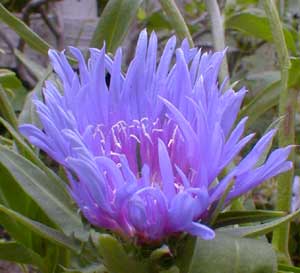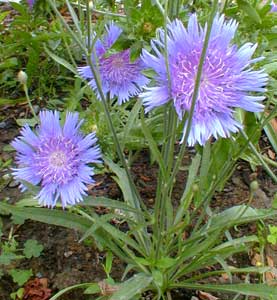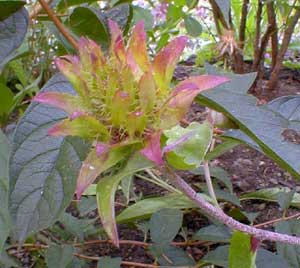
'Blue Star'
Stoke's Aster
"Chide me not, laborious band,
For the idle flowers I brought;
Every aster in my hand
Goes home loaded with a thought."
-Ralph Waldo Emerson
(1803-1882)
(1803-1882)
With an appearance halfway between a gigantic blue daisy & scabiosa, Stokesia laevis 'Blue Star' is a most appealing large-blooming & long-blooming summer & early autumn flower. It is shown in the first photo in May, & in the second photo in June.
The lacy turquoise-blue blooms if 'Blue Star' make a showy impact in the garden or for bouquets. It also does well as a container-plant.
 Deadheading insures the Stoke's Aster keeps blooming into autumn. However, late season blooms should not be cut off, if one wishes to have Autumn's large exploding-star bracted seedheads.
Deadheading insures the Stoke's Aster keeps blooming into autumn. However, late season blooms should not be cut off, if one wishes to have Autumn's large exploding-star bracted seedheads.Lasting through most of autumn, the seedheads & bracts, in green & pink, are exceedingly decorative. They can also be dried for use in dry flower arrangement.
In our region the long slender basal leaves attempt to remain evergreen through winter, but may need clipping back just before spring.
Because it is from the south, it will need winter mulch to survive winters in zones 5 or 6, where they are not evergreen, but here on Puget Sound the only winter consideration they require is protection from excess dampness.
Easy to grow in moist well-drained fertile soil in full sun, but very sensitive to excess moisture during winter dormancy, winter is in the main the only time it is at risk of dying.
 A raised bed that drains swiftly usually takes care of the threat. In the growing season, dampness isn 't apt to harm it, as it is native of seasonal bogs of the southeast coastal plains.
A raised bed that drains swiftly usually takes care of the threat. In the growing season, dampness isn 't apt to harm it, as it is native of seasonal bogs of the southeast coastal plains.This is the only species within its genus, though it has several cultivars, many quite recently developed, in a range of colors including pink, blue, purple, pale yellow & white.
Stoke's Aster is named for the early 19th Century Scottish botanist, chemist, fossil hunter, & physician, Dr. Jonathan Stokes (1755-1831).
An amusing story is told of Dr. Stokes who one wintry day was on his way to a meeting of the Lunar Men, a scientific club, & saw coiled up on the side of the road a large black & yellow snake that had frozen to death. He put the frozen snake in a pocket of his greatcoat, intending to dissect it at a later time.
During the Lunar Men club meeting, the members were astonished by the sound of angry hissing, & saw a large snake go slithering across the floor, it having thawed out in Dr. Stokes' coat pocket & made its get-away.